There are almost 20,000 species of bees in the world which have been identified to date. Bees are close relatives of ants, wasp and hornets. One genus under which all honey bees fall, Apis, contains all the known species of honey bee forming at least 44 sub species. Bees in this genus are all characterised by their abilities to produce and store honey and build comb from wax. It is these properties that mankind has learned to use by learning to harvest honey from wild colonies or managing colonies in hives.
Many of the sub species described to date have one or more other variants. Geographical isolation and breeding of favoured local bees by beekeepers has led to numerous versions of the better described sub species. Given the vast number of sub species (and it may be possible to describe many more than 44), we will only look at the main species and the better known subspecies we see in modern beekeeping and some of the more interesting species from which mankind has learned to harvest from to his advantage.
Apis mellifera (the “European” or “Western” honey bee)
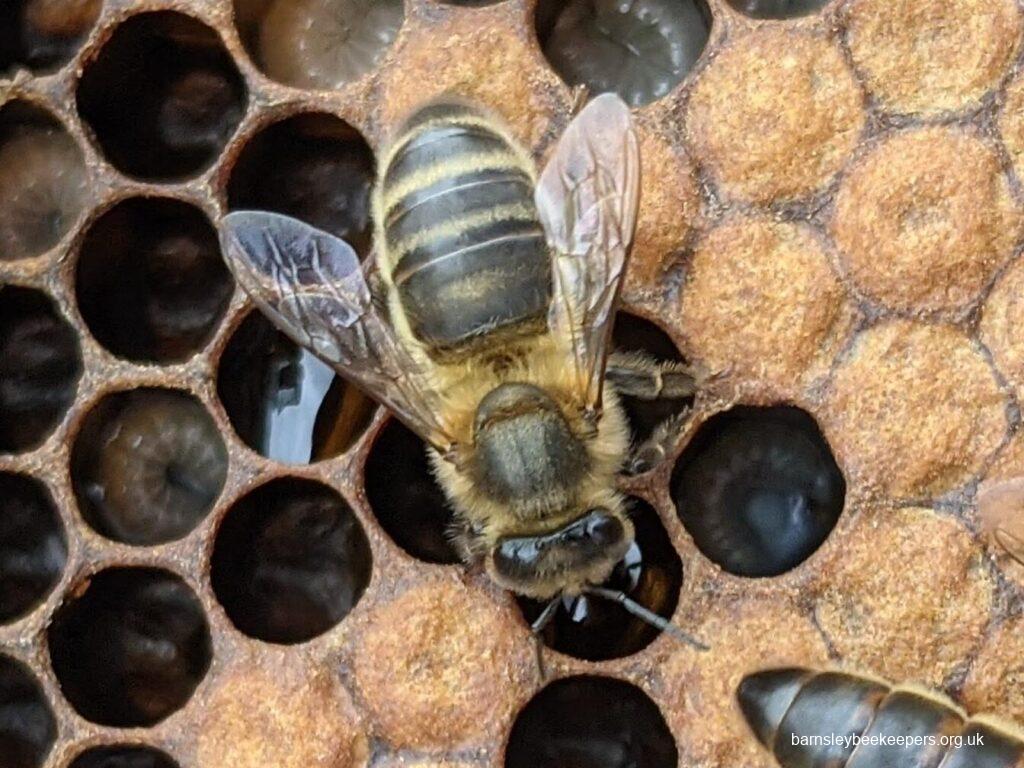
(this bee close in type to a native bee AMM)
Apis mellifera is the most wide spread species of honey bee in the world. It is the main species which has truly been “domesticated” by humans, largely due to its habit of building its nests within cavities (e.g. amongst rocks or within hollows in trees). It is due to this habit that A. mellifera lends itself to being “kept” in hives. A. mellifera has been cultivated by humans for at least 5000 years.
The species is characterised by colonies numbering 10s of thousands that form multiple combs per colony and build their colonies within cavities. The colonies can survive in a very wide range of climates (most climates occupied by humans) and can use a very wide range of food sources. Colonies can live through winters in cool temperate zones (albeit only numbering between 10 to 20% of their summer numbers) by laying down considerable stores of honey gathered through the summer months. It is these characteristics that have led humans to favour A. Mellifera.
Due to the wide geographical spread of A. mellifera, a number of sub-species have arisen; some of these being the honey bees commonly in use by beekeepers around the world today. At least 30 sub-species of A. mellifera have been described throughout its wide range. Here we look at the main sub-species that have there origins in Europe (the maps showing the areas of origin rather than their current range).
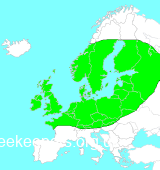
Apis mellifera mellifera (the “Northern European” or “dark” or “German” honey bee)
Here in the UK, the native bee – and hence most kept bee – is the A. mellifera mellifera. The sub-species is found throughout Britain and Ireland and extends across northern and central Europe. A. mellifera mellifera is a relative newcomer as honey bees re-entered northern Europe following the last ice age. The bees of this sub-species are typically small, stocky bees with a number of variants existing in different geographical locations. Colours can vary from jet back to dark brown. No yellow should exist on native A. mellifera mellifera however, much hybridisation has occurred with Italian bees making pure bred A. mellifera mellifera largely a thing of the past. Neither dark or Italian bees are considered to be aggressive however the hybrids of the two are often aggressive by nature causing beekeepers to spend much time and effort in developing and maintaining non-aggressive gene pools. (BIBBA aims to protect this sub-species)

Apis mellifera ligustica (the “Italian” honey bee)
A. mellifera ligustica originates in Italy and the neighbouring parts of the Mediterranean where it is believed to have survived during the last ice age. It is the most widely spread (and preferred) of all the sub-species of the western bee (A. mellifera). Italian bees are slightly smaller than their darker, northern cousins and are noted for their obvious yellow/orange banding. They are favoured for having a gentle temperament, prolific brood laying and colony build up, strong foraging abilities and they build comb very quickly with clean, white cappings. On the down side, they are known to readily rob other hives, drift between hives and eat much of their stores if available forage is not plentiful. They have become widely hybridised with other subs-species of A. mellifera across Europe and North America.
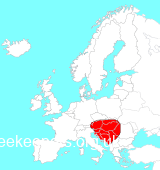
Apis mellifera carnica (the “carneolan” or “grey” bee)
Sometimes known as the Slovenian bee, due to Slovenia’s mountain ranges creating geographical isolation (and hence purity) of A. mellifera carnica, the carneolan bee is a sub-species originating in the Balkan peninsular (Austria, Hungry, Bulgaria down to Bosnia and Serbia). The sub-species is characterised by by being smaller than other European races and – due to the large amount of hairs – appears grey in colour. The carneolan bee is renowned for its gentle temperament and has become increasingly favoured by beekeepers who want ‘an easy time’ when handling bees or who wish to keep bee in their gardens. The bees over-winter with smaller colonies sizes (hence require less stores), and build up very rapidly in spring. The downside of this rapid colony expansion is that carneolan bees have a strong swarming tendency and can be difficult to manage as a result. Daughter queens resulting from cross-breeding with local strains can be be particularly aggressive.
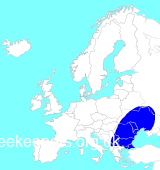
Apis mellifera macedonica (The “Macedonian” bee)
The Macedonian Bee looks similar to its northern cousin A. mellifera mellifera. Like its northern cousin, the Macedonian bee has readily hybridised with the the Italian bee. Although first described in Macedonia and northern parts of Greece, it is naturalised in an area extending all the way into the Ukraine and stretching around the north of the Black Sea towards the Middle East from where this strain is first thought to have arisen.
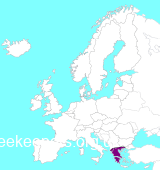
Apis mellifera cecropia (The “Greek” bee)
Very similar in appearance to the Italian bee, the Greek bee is favoured for its very mild temperament, large colony size, lack of tendency to swarm and good foraging ability. However it is renowned for being a heavy producer of propolis, making it difficult to separate hive parts and is not thought to do well in the damp and cooler climates of northern Europe. The Greek bee has often been used to produce crosses in an attempt to instil less aggression into northern bees. However, some beekeepers have reported that crosses of Greek and Northern strains often produce very aggressive colonies one or two generations on.
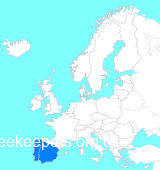
Apis mellifera iberiensis (The “Iberian” bee or “Gibraltar” bee)
An unusual bee from southern Europe, A. mellifera iberiensis (sometimes referred to as iberica) is a small, black bee that can be found throughout much of the Iberian peninsula. Although there are considerable numbers of Italian bees kept by beekeepers in the region, the Iberian bee has remained relatively pure. The sub species, thought to originate from crosses with bees from northern Africa, exhibits a high degree of polyandry, with drones actively seeking out other colonies in order to mate with queens. The drones are believed to be very specific to their own kind and this habit maintains a very pure yet genetically diverse strain. Colonies are often destroyed upon being found. The Iberian bee, although not overly aggressive, has a tendency for a handful of “sentry” bees to patrol the area around the colony up to 24 hours following a disturbance and attack any intruders. This has led to a poor reputation and the bee often ends up the loser.
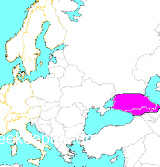
Apis mellifera caucasica (the “Caucasian” bee)
The Caucasian bee originates in the Caucasus region (the mountain range dividing South-eastern Europe from Asia). It is a large bee that – like the carneolan bee – often appears grey due to large amounts of hair; some variants can have brown spots. Like the carneolan, the Caucasian bee is very mild tempered and is quite productive however it is slow to build up to full strength and fairs poorly in cooler, damper climates further north in Europe.
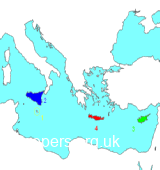
Other European Sub Species of the Western Honey Bee
A number of island dwelling sub species have been described in the Mediterranean all having become geographically isolated and specialised for their particular habitats.
A. mellifera ruttneri (the “Maltese” bee 1) – a dark medium sized bee thought to originate from bee populations that spread northward from north Africa during the period of warming following the last ice age. It is noted for being very drought tolerant and responds rapidly to seasonal changes and forage availability. It is renowned for being highly aggressive immediately around the vicinity of the colony; a fact which often leads to the destruction of colonies. The Maltese bee is noted for its high degree of resistance to varroa mite infestations. This is largely due to its fastidious hive cleaning tendency. The sub species is under threat from imported Italian strains.
A. mellifera sicula (the “Sicilian” bee 2) – a dark honey bee that is distinctly different from its yellow banded neighbour on the mainland of Italy.
A. mellifera cypria (the “Cypriot” bee 3)
A. mellifera adami (the “Cretian” bee 4)
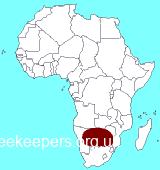
Apis mellifera scutellata (the “African” honey bee)
An otherwise unremarkable sub-species of A. mellifera originating in central southern Africa, the African bee has become infamous through the extreme aggression of its progeny following introduction to South America, and being termed the “Africanised bee” or “killer bee”.
In fact, the A. mellifera scutellata is no more aggressive than most other sub-species of A. mellifera. However, in 1957 scientists in South Eastern Brazil who were conducting experiments on the interbreeding of the African bee with other forms of European A. mellifera (in an attempt to improve local stocks of bees) allowed the escape of some of the resulting hybrids. The African bee, when mated with other forms of European bee (mainly the Italian bee), were noted for their defensiveness. Hybrid colonies were found to have guard bees patrolling an area extending up to 20 or 30 metres from the colony and would send out several times the number of bees to defend the colony as other strains of A. mellifera with a tendency to pursue any threats over long distances. Another worrying trait shown by this new Africanised hybrid was its tendency to enter and take over (killing the incumbent queen) the colonies of other strains of European bee resulting in rapid expansion. The Africanised bee has worked its way up through Central America and Mexico and is now a problem in a most southern states of the USA.
Apis mellifera scutellata is actually under threat. The Cape bee (A. mellifera capensis) from southern South Africa readily invades the colonies of African bees. The Cape bee workers are capable of laying eggs that turn into clones of themselves, known as thelytoky (from the Greek thēlys “female” and tokos “birth”), gradually growing in numbers and taking over the colony. Thelytoky is a type of parthogenesis – a type of asexual reproduction in which the offspring develops from unfertilized eggs
Apis cerana (the “Asiatic” or “Eastern” or “Himalayan” honey bee)
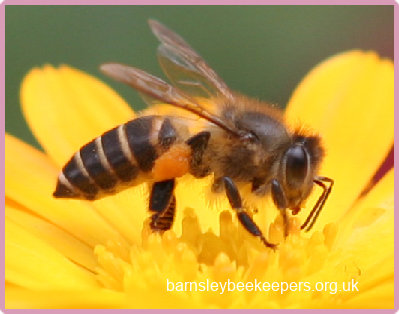
Apis cerana is found in a vast range from northern India, across southeast Asia to Malaysia, Indonesia, the Philippines and Japan. Like A. mellifera, cerana is a cavity nesting bee making it suitable for housing in a hive. The species is kept extensively by farmers across this vast region although due to having a smaller colony size than the Western honey bee (A. mellifera) its honey yields are quite small. This has led to wide scale importation of the Western bee which in turn has led to bee diseases of A. cerana crossing over to A. mellifera – most notably the varroa mite.
A. cerana is characterised by a smaller (around ¾ the length of A mellifera), narrower body than that of the Western bee and has quite marked yellow bands between the abdominal segments. It is renowned for adapting to seasonal changes (in temperature and flora) rapidly. The species is found in habitats ranging from low land forest and scrub to high mountain passes in the Himalayas. In fact it is reported that A. cerana can survive short spells at freezing point – at which point A. mellifera would have long since died.
The Asiatic bee has co-existed with some notable problems for thousand of years. Two diseases which affect Western bees, varroa and Nosema ceranae, present little problem to the Asiatic bee due to its hygienic behaviour. They have a strong grooming trait and are known to renew the wax of brood comb on a continuous basis thus keeping pathogen levels to a minimum.
Many will have seen the Asiatic honey bee on video clips from the National Geographic channel. The Asiatic bee faces a number of fearsome predators in the Asian hornet, the largest of which is the Japanese giant hornet. The latter being 5 times larger than the honey bee can destroy entire honey bee colonies numbering 30,000 bees within 2 to 3 hours. Once a scout hornet finds a bee colony, other hornets are led to the colony and proceed to attack the bees until all are dead, leaving the hornets free to gorge themselves on the honey and take the bee larvae back their nest to feed to their own young. The Asiatic honey bee has learned to adapt to this onslaught. The bees are unable to take on such a large predator one-on-one, however several dozen bees immediately surround the hornet and vibrate their wing muscles. The combined activity of all these bees raises the temperature and “cooks” the hornet to death. Imported stocks of Western honey bee have no defence against this predator.
Apis dorsata (the “giant” honey bee)
The giant honey bee is found in locations across southern and south east Asia. It is typically found in densely forested areas and nests beneath large branches and under rocky over-hangs of cliffs. One sub species (A. dorsata laboriosa) was made famous when Jimmy Doherty (from Jimmy’s Farm) was seen descending down a cliff face on a rope whilst cutting away honey comb and dropping it into an awaiting basket on a large stick.
The giant honey bees are – as their name suggests – much larger than A. mellifera. They are typically very aggressive when provoked however, indigenous peoples routinely harvest honey and wax from colonies whilst wearing the simplest of protection, if any. The bees are known to be prolific producers of honey. They produce large, exposed combs (not cavity nesting) and typically do this more than once per year as they migrate between different areas according to the changes in the seasons.
Due to the giant honey bee not building its combs in enclosed cavities (like A. mellifera), it has never been domesticated.
Apis florea (the “red dwarf” honey bee) and Apis andreniformis (the “black dwarf” honey bee)
Existing as two species (A. florea – the red dwarf honey bee and A. adreniformis – the black dwarf honey bee), the dwarf honey bee inhabits a range extending throughout southern and south eastern Asia. Dwarf bees are probably the most distinct of all honey bee species and are believed to have separated from the other lineages of honey bee some 40 million years ago. The dwarf honey bee provides a “snap-shot” of what the early honey bees may have been like.
The dwarf bee – as its name suggests – is characteristically small and produces small, simple nests. Their nests are exposed and are typically built on small branches of bushes and trees. In fact they may at first look like small swarms having escaped from a Western honey bee hive. The bees cover parts of the branch, on which the nest hangs, with propolis which acts to deter ants and other crawling invaders.
Apis nigrocincta
Closely related to A. cerana, A. nigrocincta has become slightly distinct from its more widespread neighbour due to its isolation on a handful of islands in Indonesia and the Philippines.
